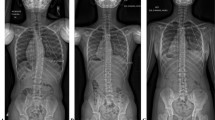Abstract
Purpose
CAD/CAM technology is a newer technique for creating spinal orthoses than standard plaster molded methods. To our knowledge there has been only one previous study of CAD/CAM braces. The purpose of our study was to compare patient preference and in-brace correction of Cobb angle between plaster molded thoracolumbosacral orthoses (TLSO) and CAD/CAM designed TLSOs in a series of patients with scoliosis.
Methods
Ten patients with an average initial Cobb angle of 30.8° (range 18°–46°) had both a plaster molded TLSO and a CAD/CAM TLSO fabricated for them. In each case, the decision to brace was made by the treating surgeon based on curve magnitude and skeletal maturity. After 3 weeks of 23 h a day wear, in-brace correction of the Cobb angle was measured for each brace based on standard PA spine radiographs. After 3 months of use, patients were asked which brace they preferred.
Results
For the CAD/CAM brace, the mean curve correction after 3 months was 51% compared to 44% in the plaster molded TLSO cohort. (p = 0.46). Seven out of nine patients preferred the CAD/CAM TLSO over the plaster molded TLSO. There were no brace complications in either group.
Conclusion
In our matched cohort study, CAD/CAM TLSOs had at least equivalent if not superior correction of the Cobb angle compared to standard plaster molded TLSOs; 78% of our patients preferred the CAD/CAM brace over the standard TLSO.



Similar content being viewed by others
References
Allington NJ, Bowen JR (1996) AIS: treatment with the Wilmington brace. A comparison of full-time and part-time use. J Bone Joint Surg Am 78A:1056–1062
D’Amato CR, Griggs S, McCoy B (2001) Nighttime bracing with the Providence brace in adolescent girls with idiopathic scoliosis. Spine 26:2006–2012
Emans JB, Kaelin A, Bancel P, Hall JE, Miller ME (1986) The Boston bracing system for idiopathic scoliosis. Follow-up results in 295 patients. Spine 11:792–801
Fernandez-Feliberti R, Flynn J, Ramirez N, Trautmann M, Alegria M (1995) Effectiveness of TLSO bracing in the conservative treatment of AIS. J Pediatr Orthop 15:176–181
Gabos PG, Bojescul JA, Bowen JR, Keeler K, Rich L (2004) Long-term follow-up of female patients with idiopathic scoliosis treated with the Wilmington orthosis. J Bone Joint Surg Am 86:1891–1899
Howard A, Wright JG, Hedden D (1998) A comparative study of TLSO, Charleston, and Milwaukee braces for idiopathic scoliosis. Spine 23:2404–2411
Katz DE, Durrani AA (2001) Factors that influence outcomes in bracing large curves in patients with AIS. Spine 26:2354–2361
McCollough NC, Schultz M, Javech N, Latta L (1981) Miami TLSO in the management of scoliosis: preliminary results in 100 cases. J Pediatr Orthop 1:141–152
Nachemson AL, Peterson LE (1995) Members of brace study group of the SRS. Effectiveness of treatment with a brace in girls who have AIS. J Bone Joint Surg Am 77A:815–822
Peltonen J, Poussa M, Ylikoski M (1988) Three-year results of bracing in scoliosis. Acta Orthop Scand 59:487–90
Piazza MR, Bassett GS (1990) Curve progression after treatment with the Wilmington brace for idiopathic scoliosis. J Pediatr Orthop 10:39–43
Rowe DE, Bernstein SM, Riddick MF, Adler F, Emans JB, Gardner-Bonneau D (1997) A meta-analysis of the efficacy of non-operative treatments for idiopathic scoliosis. J Bone Joint Surg Am 79A:664–674
Upadhyay SS, Nelson IW, Ho EK, Hsu LC, Leong JC (1995) New prognostic factors to predict the final outcome of brace treatment in AIS. Spine 20:537–545
Wiley JW, Thomson JD, Mitchell TM, Smith BG, Banta JV (2000) Effectiveness of the Boston brace in treatment of large curves in AIS. Spine 25:2326–2332
Richards BS, Bernstein RM, D’Amato CR, Thompson GH (2005) Standardization of criteria for adolescent idiopathic scoliosis brace studies. Spine 18:2068–2075
Zeid I (1991) CAD/CAM theory and practice. McGraw–Hill International Editions. Computer Science Series
Wong MS, Cheng JC, Lo KH (2005) A comparison of treatment effectiveness between the CAD/CAM method and the manual method for managing adolescent idiopathic scoliosis. Prosthet Orthot Int 29:105–111
Jarell M (2006) CAD/CAM technology in the O&P industry. In: O&P Business News, 15. Slack Incorporated, Thorofare, NJ, pp 24–32
Author information
Authors and Affiliations
Corresponding author
About this article
Cite this article
Sankar, W.N., Albrektson, J., Lerman, L. et al. Scoliosis in-brace curve correction and patient preference of CAD/CAM versus plaster molded TLSOs. J Child Orthop 1, 345–349 (2007). https://doi.org/10.1007/s11832-007-0066-9
Received:
Accepted:
Published:
Issue Date:
DOI: https://doi.org/10.1007/s11832-007-0066-9




